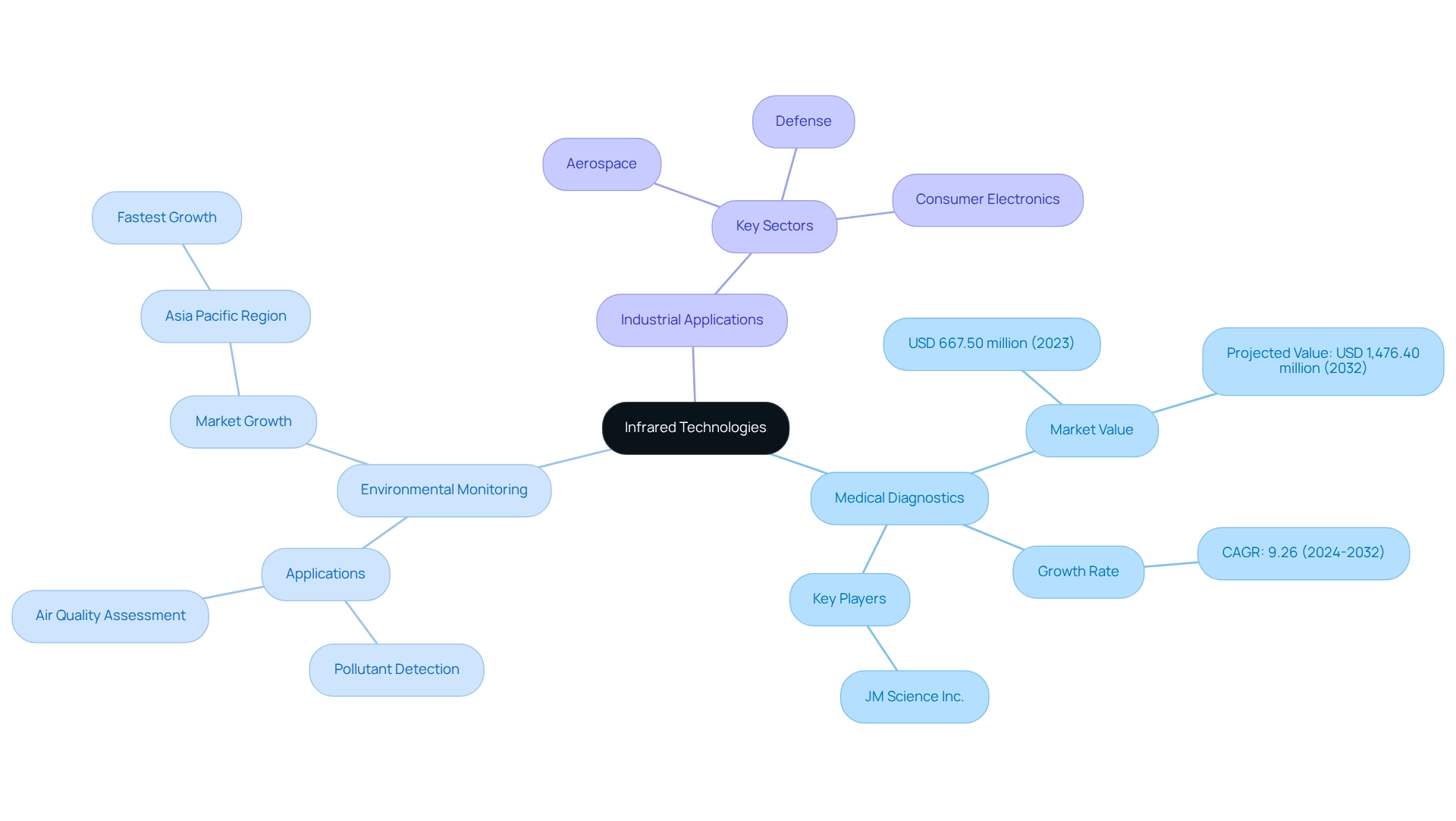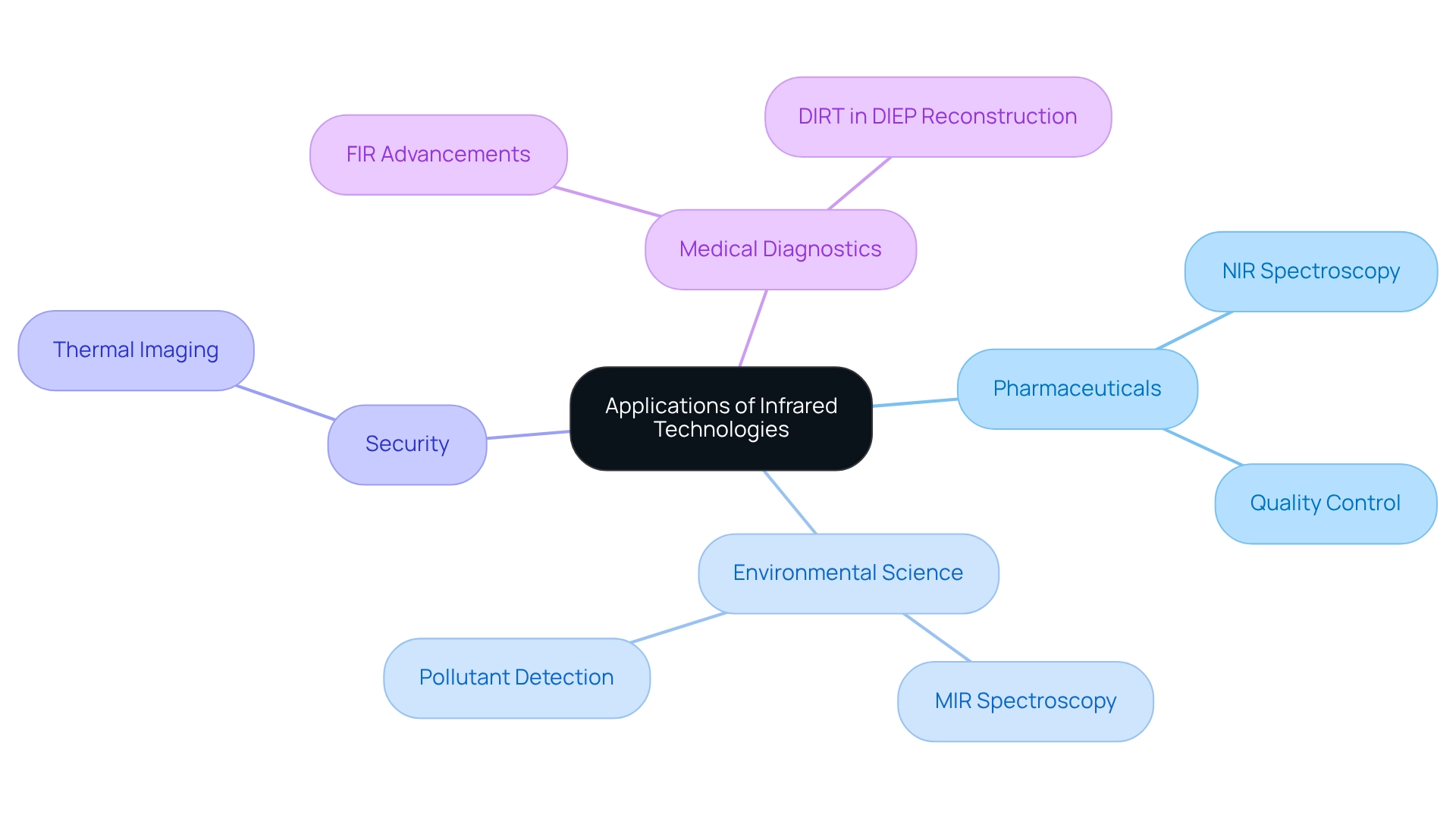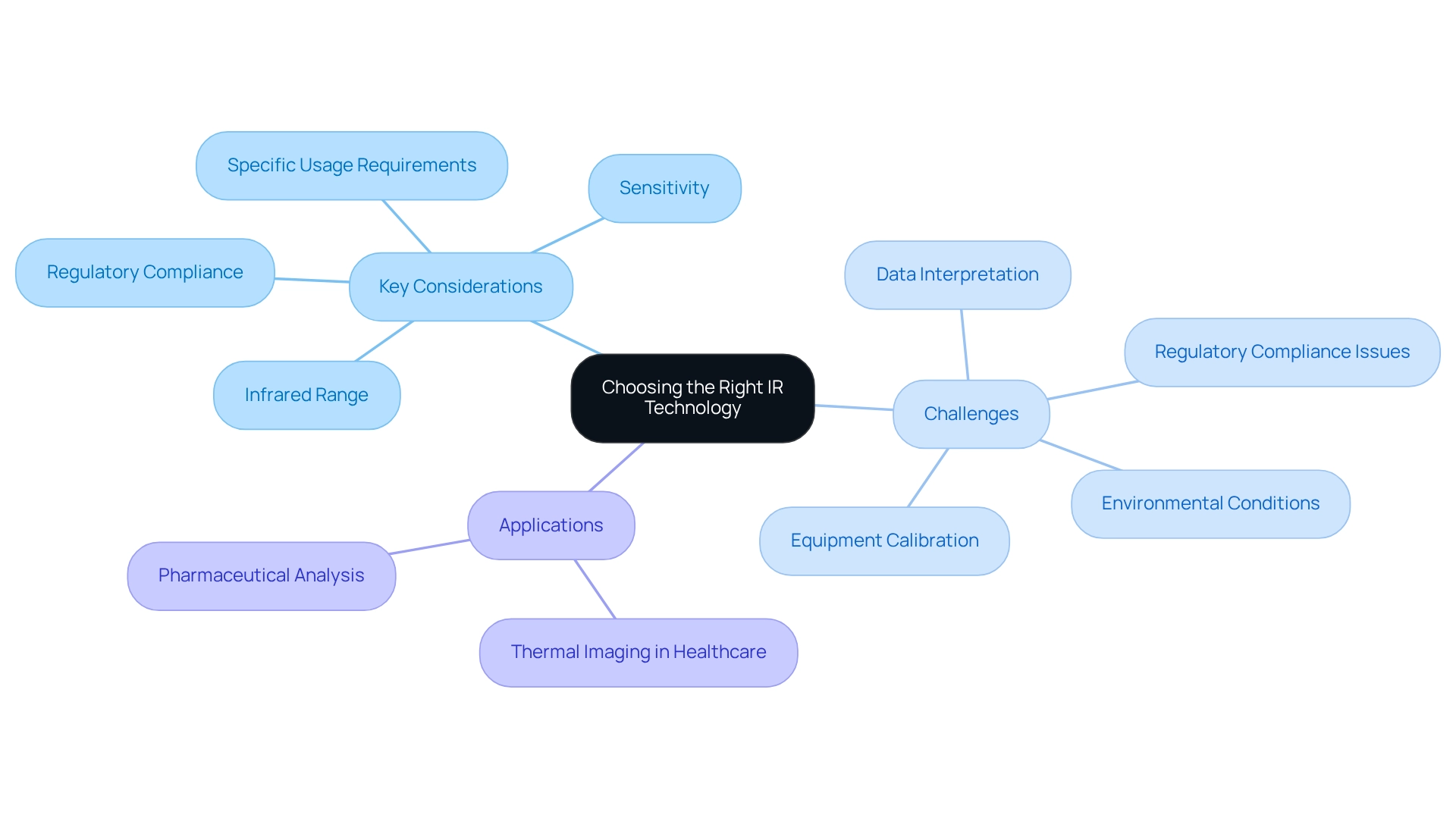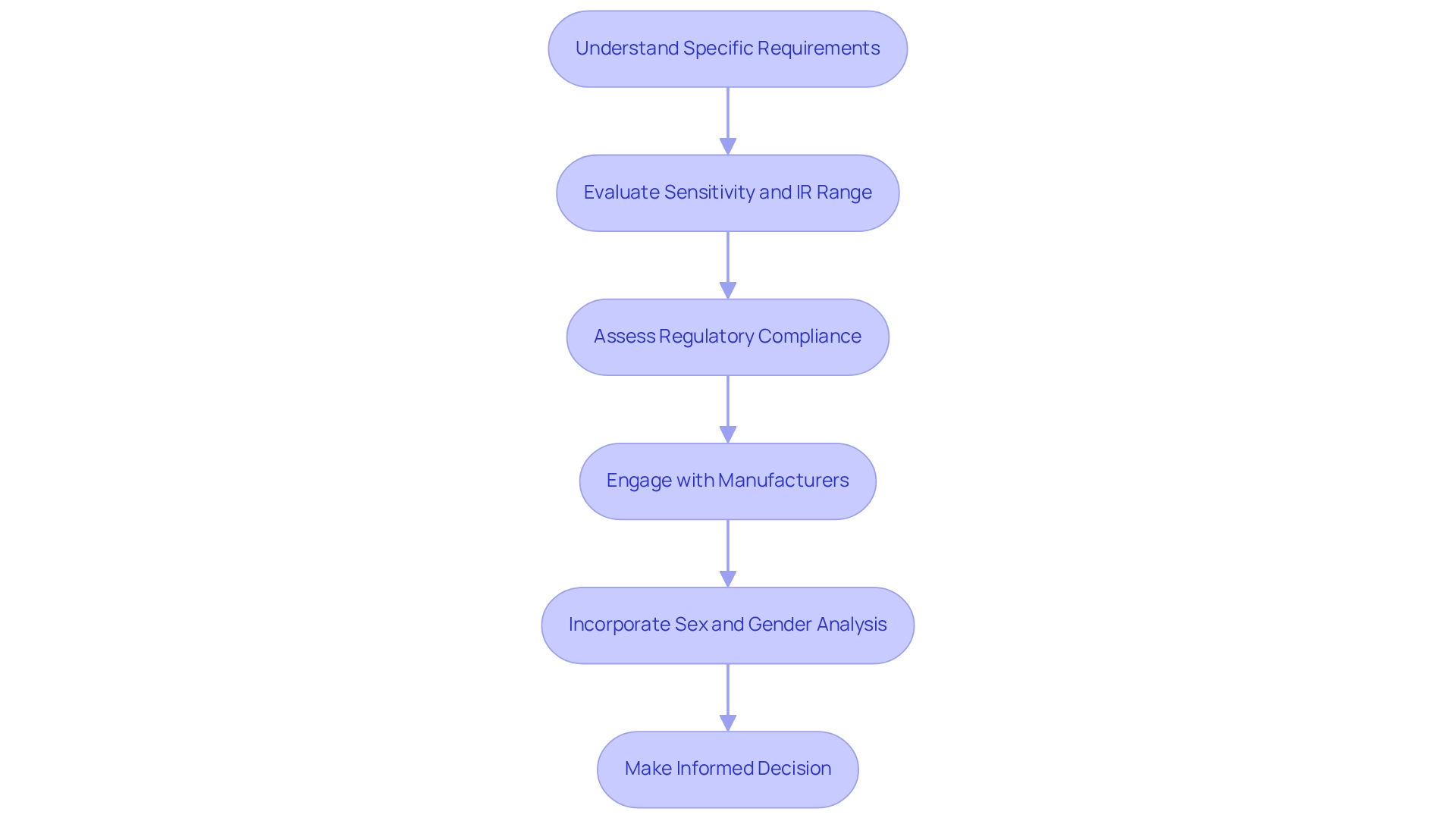Overview
This article delves into various infrared (IR) range technologies, highlighting their applications in medical diagnostics, environmental monitoring, and industrial settings. By doing so, it equips readers with the knowledge necessary to determine the most suitable technology for their specific needs. Key factors such as:
- Sensitivity
- Specific usage requirements
- Regulatory compliance
are emphasized, illustrating that a comprehensive understanding of these elements is crucial for selecting the appropriate IR technology. Such informed choices lead to effective and efficient applications across diverse fields, ultimately enhancing operational outcomes.
Introduction
In an age where precision and efficiency reign supreme across various industries, infrared technologies have emerged as a transformative force. These innovative tools harness the power of infrared radiation, delivering critical insights and enhancing operational capabilities in applications ranging from medical diagnostics to environmental monitoring.
As the demand for non-invasive diagnostic methods and real-time monitoring solutions escalates, grasping the intricacies of infrared technologies becomes essential. This article explores the diverse applications, types, and advancements within this field, illuminating how these technologies are reshaping industries and paving the way for future innovations.
Understanding Infrared Technologies: An Overview
IR methods represent a diverse array of techniques that harness radiant heat within the infrared range of the electromagnetic spectrum, situated between visible light and microwaves. These technologies are essential across multiple sectors, including medical diagnostics, environmental monitoring, and industrial applications. The capacity to detect and quantify thermal energy renders systems operating in the infrared range indispensable for non-invasive evaluations and analyses, significantly enhancing diagnostic accuracy and operational efficiency.
In the realm of medical diagnostics, these systems have undergone remarkable advancements. For example, the thermal sensor market was valued at approximately USD 667.50 million in 2023 and is projected to reach USD 1,476.40 million by 2032, reflecting a compound annual growth rate (CAGR) of 9.26% from 2024 to 2032, as noted by Jagney Dave, Vice President of Client Engagement. This growth is driven by an increasing demand for non-invasive diagnostic tools that improve patient care and streamline clinical workflows.
Recent trends indicate a notable rise in the application of thermal technologies in healthcare settings. Notably, the North American market led the sensor sector in 2023, capturing a 35.7% share, primarily due to heightened demand in aerospace, defense, and healthcare. The integration of heat-sensitive sensors in medical devices expands the infrared range for real-time monitoring and diagnostics, thereby enhancing patient outcomes.
JM Science Inc. plays a pivotal role in this domain by continually updating its product offerings and cultivating robust partnerships with leading manufacturers, ensuring they meet the evolving needs of the scientific community.
Moreover, the importance of thermal imaging extends to environmental monitoring, where are employed to detect pollutants and assess air quality. The Asia Pacific region is anticipated to experience the fastest growth in this sector, driven by industrial expansion and rising demand for consumer electronics, particularly in automotive safety applications.
As we delve deeper into the specific types of infrared innovations and their applications, it becomes evident that these advancements are not only transforming medical diagnostics but also playing a vital role in environmental management and industrial productivity.

Types of Infrared Technologies: Near, Mid, and Far IR
Infrared technologies are categorized into three primary types based on their infrared range: near-infrared (NIR), mid-infrared (MIR), and far-infrared (FIR). NIR, ranging from 0.75 to 1.4 micrometers, is widely employed in spectroscopy and remote sensing applications. Its rapid detection capabilities render it particularly valuable in pharmaceutical settings, where efficiency is paramount.
For instance, NIR spectroscopy has been shown to significantly reduce evaluation time compared to traditional microscopy detection, which typically requires approximately 15 minutes.
The IR range, spanning wavelengths from 1.4 to 5.6 micrometers, plays an essential role in chemical examination and environmental observation. This range is adept at interacting with molecular vibrations, thereby facilitating the identification of chemical compositions and the assessment of material properties. The market for mid-infrared innovations is poised for considerable expansion, with critical applications in pharmaceuticals where precise chemical analysis in is essential.
Notably, the IR range sector is expected to attract increased investment, underscoring the rising demand for sophisticated analytical methods within the pharmaceutical field.
FIR, which spans from 5.6 micrometers to 1 millimeter, is primarily utilized in thermal imaging and heating applications. While it may not be as prevalent in chemical evaluation as NIR and MIR, its unique characteristics in the infrared range are vital for numerous industrial applications.
Understanding the distinctions among these methods is crucial for selecting the appropriate approach within the infrared range for specific applications. For example, a recent study assessing the geographical origin of , analyzing three varieties: 'Nocciola Piemonte', 'Tonda Gentile Romana', and 'Mortarella'. The study achieved classification accuracy rates between 89% and 100% for authentic samples, with promising results for blended and real samples, particularly fresh and roasted hazelnuts, which yielded accuracy rates of 81% and 91%.
This case exemplifies NIR's efficacy as a rapid, non-invasive, and cost-effective method for authenticity verification in food products.
As the thermal imaging landscape evolves, ongoing research is anticipated to explore the applicability of advanced models, such as the BEST-1DConvNet, to enhance automatic parameter adjustments across a broader range of substances. Shuangcheng Deng, the author of a study on quantitative analysis using this model, highlights its potential to streamline processes in pharmaceutical analysis. This advancement could further underscore the significance of thermal systems within the infrared range in contemporary scientific applications.
In the broader context, Europe is projected to account for the largest revenue share of 40% by 2037, with Germany leading in healthcare expenditure. This statistic emphasizes the growing importance of thermal imaging technologies in the pharmaceutical sector, highlighting the necessity for lab managers to stay informed about market trends and opportunities.
The Science Behind Infrared Spectroscopy: Principles and Applications
Infrared spectroscopy stands as a pivotal analytical method, meticulously assessing the absorption of thermal light by molecules. This technique provides vital insights into their structural and compositional characteristics. At its essence, infrared spectroscopy relies on the interaction of IR radiation with molecular vibrations, where specific wavelengths are absorbed by distinct functional groups within a molecule. This unique attribute facilitates the identification of chemical compounds and the analysis of material properties, making spectroscopy indispensable in both research and industrial applications.
The adaptability of thermal spectroscopy extends to environmental monitoring, playing a significant role in detecting pollutants and evaluating environmental health. Its non-destructive nature and ability to deliver rapid results enhance its utility, particularly in pharmaceutical laboratories where precision and efficiency are critical. Notably, the spectral analysis market is projected to grow at a rate of 4.6%, underscoring its increasing acceptance across various sectors.
Recent case studies underscore the substantial impact of infrared spectroscopy within the pharmaceutical industry, especially regarding the identification of chemical compounds. For instance, Europe led the IR range spectroscopy market in 2022, capturing over 38.89% of the revenue share, primarily due to the presence of major pharmaceutical manufacturers and strong regulatory support for IR range applications. Concurrently, the Asia Pacific region is anticipated to emerge as the fastest-growing market, boasting a compound annual growth rate (CAGR) of 6.3%, propelled by advancements in IR range spectroscopy technologies in countries such as India and Japan.
Expert insights accentuate the importance of thermal spectroscopy in catalysis research, with researchers asserting that it "undoubtedly represents one of the most important tools in catalysis research." This method not only aids in chemical examination but also enhances the understanding of complex chemical interactions, thereby fostering advancements in multiple scientific fields. As the realm of thermal spectroscopy continues to progress, its applications in pharmaceuticals and environmental monitoring remain paramount, reinforcing its status as an essential tool in .
JM Science Inc. offers a comprehensive range of high-performance liquid chromatography (HPLC) solutions, including Shodex, CapcellPak, and Reprosil columns, which are vital for effective evaluation alongside infrared spectroscopy. Furthermore, our specialized titrators deliver precise measurements that bolster the reliability of analytical outcomes. Explore JM Science's premier scientific instruments to equip your laboratory with the essential resources for advanced research and analysis.
Applications of Infrared Technologies: From Pharmaceuticals to Security
Infrared technologies are integral to numerous fields, showcasing their versatility and impact. In the pharmaceutical industry, Near-Infrared (NIR) spectroscopy plays a crucial role in quality control, particularly in monitoring active pharmaceutical ingredients (APIs) throughout the manufacturing process. This technique not only ensures compliance with stringent quality standards but also enhances efficiency, as evidenced by studies indicating that NIR can achieve remarkably low Root Mean Square Error of Cross-Validation (RMSECV) values when analyzing compounds like Ginkgo biloba leaf extracts, which exhibit the lowest RMSECV value in total flavonoid content analysis.
In environmental science, Mid-Infrared (MIR) spectroscopy is employed to detect pollutants and assess atmospheric conditions, providing critical data for environmental monitoring. Recent advancements in thermal imaging devices have highlighted the integration of , which enhance the accuracy and reliability of pollutant detection. Furthermore, developments in 2D correlation spectroscopy have introduced new concepts and data pretreatment methods, significantly advancing analytical techniques in this field.
Thermal imaging, a branch of infrared methods, is increasingly employed in security applications. It significantly improves surveillance capabilities, enabling the detection of intruders even in low-light conditions, thereby enhancing safety measures in various settings.
Moreover, Far-Infrared (FIR) advancements are making strides in medical diagnostics, providing non-invasive imaging and treatment alternatives that are transforming patient care. For instance, the use of DIRT in DIEP breast reconstruction has shown potential in preoperative planning, intraoperative evaluation, and postoperative assessment of perfusion status. As Marzena Jamrógiewicz points out, "some drawbacks of this approach are emphasized and future possibilities are expected," underscoring the necessity for a balanced perspective on thermal methods.
The scope of these applications highlights the crucial role of thermal methods in fostering innovation across sectors, particularly in pharmaceuticals and environmental science. As the field continues to evolve, staying abreast of current trends and advancements will be essential for effectively utilizing these tools.

Choosing the Right IR Technology: Key Considerations and Challenges
Selecting the appropriate infrared system involves several crucial factors that can significantly influence efficiency in laboratory environments. Key considerations include:
- Specific usage requirements
- Sensitivity
- Infrared range
- Adherence to regulatory compliance
For example, near-infrared (NIR) methods are often favored for their rapid analysis capabilities in pharmaceutical contexts, while far-infrared (FIR) systems are particularly effective in thermal imaging applications.
Nevertheless, the implementation of thermal imaging technologies presents its own set of challenges. Environmental conditions can impact performance, highlighting the necessity for and robust data interpretation strategies. A minimum equilibration period of 15 minutes is essential for patient acclimation to the room, emphasizing the critical role of preparation in achieving accurate results.
Moreover, regulatory compliance poses a significant obstacle. Practical examples illustrate how laboratories have navigated these challenges, ensuring their thermal technologies meet stringent industry standards. Notably, advancements in thermal conformal optics underscore the importance of minimizing aberrations and enhancing aerodynamic performance, particularly in aerospace applications, while adhering to regulatory requirements.
Expert insights underscore the necessity of understanding these challenges for successful implementation. Guanghao Sun remarked, "Our cost-effective thermopile array appears promising for future close-range fever screening of patients with infectious diseases at primary care doctor clinics, health care centers, and quarantine stations in both developing and developed countries." This perspective highlights the practical applications of thermal imaging within healthcare settings.
Furthermore, a study on Frey's syndrome correlated subjective symptoms with thermal imaging measurements, indicating its potential as a quantitative diagnostic tool. As the field of thermal imaging evolves, particularly within pharmaceuticals, it is imperative to consider these vital aspects to optimize the benefits of infrared range and enhance overall operational efficiency.

Innovations in Infrared Technologies: What’s New in the Field?
Recent advancements in thermal technologies have led to the emergence of high-definition thermal cameras, advanced near-infrared (NIR) sensors, and cutting-edge materials for thermal detection. These innovations significantly enhance the sensitivity and precision of thermal measurements, facilitating more accurate evaluations across a wide range of applications. Notably, the incorporation of artificial intelligence (AI) into thermal imaging systems has transformed data processing, allowing for real-time analysis and anomaly detection.
This capability streamlines decision-making processes in security and industrial monitoring, while also improving operational efficiency. As LYNRED emphasizes, with over 35 years dedicated to developing and refining its expertise in thermal imaging, very few professionals in this field can claim such a high level of proficiency. Furthermore, emerging technologies such as quantum thermal sensors and terahertz imaging are anticipated to expand the applications within the infrared spectrum of thermal solutions.
is poised for growth, particularly within the security and surveillance sectors, as companies adapt to the post-Covid landscape and leverage these advancements to maintain competitiveness. As the field of thermal imaging continues to evolve, these innovations are set to broaden the infrared range of applications, rendering thermal solutions increasingly versatile and effective in addressing contemporary challenges.
Making Informed Choices: A Guide to Selecting IR Technologies
Selecting necessitates a comprehensive understanding of specific requirements, the distinct characteristics of various IR types, and the latest advancements in the field. A critical step in this process involves evaluating the sensitivity and IR range essential for the intended application. For instance, a study on thermal imaging (IRT) for fever screening revealed that while IRT can effectively identify individuals with elevated body temperatures, it also highlighted a significant rate of false positives, particularly with forehead measurements.
The evaluation indicated that utilizing maximum eye temperature provided a more reliable diagnostic performance, achieving an area under the curve (AUC) of 0.72, which translates to 72% accuracy in classifying true positives and negatives.
In recent years, on-rail robots have seen increased deployment in substations, capable of autonomously capturing IR images of equipment. This showcases advancements in IR innovations that significantly enhance operational efficiency.
Beyond sensitivity and the IR range, adherence to regulatory compliance is paramount when implementing thermal solutions. This compliance ensures that selected systems meet industry standards and can be seamlessly integrated into existing workflows. Understanding the characteristics of IR range technology, including its density and intensity, is essential for optimizing performance and achieving accurate results. Best practices for selecting infrared technology in pharmaceuticals involve engaging with manufacturers to gain insights into the latest innovations and leveraging expert resources for guidance.
This collaborative approach is instrumental in addressing potential implementation challenges and enhancing analytical capabilities. Furthermore, integrating sex and gender-based analysis into research design has been underscored to improve precision in IR applications, emphasizing the necessity for clear definitions to prevent ambiguity.
By synthesizing these elements—sensitivity, regulatory compliance, and expert engagement—users can make informed decisions that align with their operational needs and drive advancements in their analytical processes.

Conclusion
The exploration of infrared technologies underscores their profound impact across multiple sectors, spanning medical diagnostics, environmental monitoring, and industrial applications. These technologies, categorized into near, mid, and far infrared, are meticulously tailored to meet specific application needs, thereby enhancing efficiency and accuracy in various processes. The burgeoning market for infrared solutions highlights an increasing reliance on non-invasive diagnostic tools and real-time monitoring systems, reflecting a decisive shift towards innovation and precision within the industry.
As advancements continue to emerge—such as the integration of artificial intelligence and novel sensor technologies—the potential applications of infrared solutions are expanding at an unprecedented rate. These innovations not only bolster operational efficiency but also pave the way for new avenues in research and development. The critical importance of selecting the appropriate infrared technology cannot be overstated, as it directly influences the effectiveness of applications in laboratory settings and beyond.
In conclusion, the significance of infrared technologies in shaping the future of diagnostics, environmental monitoring, and industrial processes is unequivocal. By comprehensively understanding the intricacies of these technologies and remaining informed about the latest advancements, industries can strategically leverage their capabilities to drive innovation and enhance overall performance. As the landscape of infrared technology evolves, embracing these tools will be essential for meeting the demands of an increasingly complex and dynamic world.




